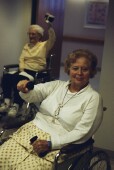
FRIDAY, April 16 (HealthDay News) — Robotic aids can help stroke patients make small but significant improvements in their ability to move their limbs, and gain a better outlook on life, new research finds.
The study, by the U.S. Department of Veterans Affairs and published online April 16 in the New England Journal of Medicine, offers the strongest evidence yet that stroke sufferers can regain limb movement long after an injury, through “intensive therapy with specially trained personnel and newly created robotic aids,” the researchers said.
The study included 127 veterans who had experienced a stroke that resulted in moderate to severe disability in an arm. The strokes had occurred at least six months earlier and, on average, five years earlier, according to the report.
While some research has suggested that long-term physical therapy doesn’t help patients if it’s given more than six months after a stroke, recent research has contradicted those findings.
In this new study, the participants were divided into three groups: one group was assigned to upper-limb therapy aided by robots designed at the Massachusetts Institute of Technology; a second group participated in similar upper-limb exercises with a therapist; and the third group received general health care but no special stroke therapy for their arm (“usual care”).
Those who underwent 12 weeks of therapy using the robotic device reported statistically significant improvements in their quality of life, and greater improvements in their upper-limb function compared with those receiving usual care, the researchers found.
The patients in the robot-assisted therapy group were seated at a table with their stroke-affected arm attached to the device, and were prompted to move a cursor on a screen. The robot sensed if they had trouble performing the task, and assisted their movements. These assisted body movements helped the stroke-damaged brain learn to compensate for the lost function and begin to “rewire” itself, the study authors explained in a news release from Brown University.
“We believe that by gaining more function and better control of their affected arms, patients were able to get out and do more, translating their motor benefits into additional meaningful social activity and participation,” study lead author Albert Lo, assistant professor of neurology at Brown University, said in the news release.
“There are about 6.4 million stroke patients in the U.S. with chronic deficits. We’ve shown that with the right therapy, they can see improvements in movement, everyday function and quality of life,” Lo added. “This is giving stroke survivors new hope.”
More information
The U.S. National Institutes of Health has more on recognizing the signs of stroke.

